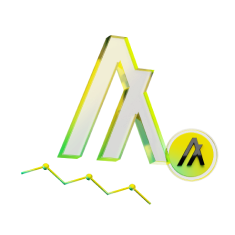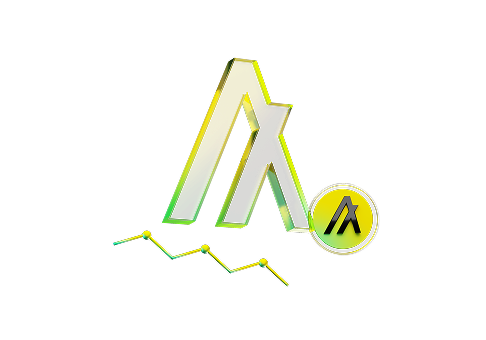What is Algorand and How Does It Work
Algorand stands out as a Layer 1 blockchain that tackles the famous blockchain trilemma head-on. The network processes thousands of transactions per second while maintaining rock-solid security and true decentralization. Built specifically for high-volume transactions and enterprise use, Algorand has positioned itself as the go-to blockchain for real-world asset tokenization and ISO 20022-compliant financial applications.
The blockchain achieves immediate transaction finality in under 4 seconds. This means when you send ALGO tokens or interact with a smart contract, the transaction becomes permanent almost instantly. No waiting for multiple confirmations. No worrying about potential reversals. The network handles between 1,000 and 5,000 transactions per second today, with peak capacity expected to reach 6,000 TPS as dynamic block times improve.
Transaction fees remain incredibly low at less than half a penny. Most users pay between $0.001 and $0.005 per transaction, making Algorand practical for everyday payments and micro-transactions. The network has also maintained carbon neutrality since 2021 through its efficient Pure Proof-of-Stake consensus mechanism.
Review ALGO Price on LBank
Prezzo ALGO()
Il prezzo attuale di
Pure Proof of Stake Consensus Mechanism Explained
Pure Proof-of-Stake (PPoS) sets Algorand apart from other blockchain networks. The system randomly selects validators for each block using a Verifiable Random Function (VRF). This cryptographic lottery happens behind the scenes every few seconds. No one knows who will validate the next block until the moment arrives.
The process works through two key roles: block proposers and voting committee members. The VRF picks these participants based on the amount of ALGO they hold. More tokens mean higher chances of selection, but even small holders can participate. The beauty lies in the unpredictability. Attackers cannot target specific validators because they don't know who they are until after the block gets proposed.
PPoS eliminates the risk of blockchain forks entirely. The protocol reaches consensus on one block at a time before moving forward. This design choice ensures that once a transaction appears on the blockchain, it stays there permanently. The system requires minimal computational power compared to proof-of-work chains like Bitcoin (BTC). Any device capable of running a basic node can participate in consensus.
Silvio Micali and the Birth of Algorand
MIT professor Silvio Micali founded Algorand in 2017 with a clear vision: create a blockchain that actually works for real-world applications. Micali brought serious credentials to the project. He won the Turing Award, computer science's highest honor. He co-invented zero-knowledge proofs, probabilistic encryption, and verifiable random functions — technologies that now power modern cryptography.
Micali spent two years developing the Pure Proof-of-Stake mechanism before launching the mainnet in June 2019. He believed existing blockchains made too many compromises. Bitcoin was secure but slow. Other chains were fast but centralized. Algorand aimed to deliver speed, security, and decentralization without trade-offs.
The Algorand Foundation, based in Singapore, now manages the ecosystem's growth. The foundation focuses on developer grants, ecosystem partnerships, and governance initiatives. The team has attracted notable partnerships with Mastercard, FIFA, and multiple central banks exploring digital currencies.
ALGO Tokenomics and Staking Rewards
The ALGO coin serves multiple purposes within the Algorand ecosystem. Users need ALGO to pay transaction fees, participate in DeFi protocols, and secure the network through staking. The token has a fixed maximum supply of 10 billion, with approximately 8.8 billion already in circulation.
Staking ALGO offers several advantages over other proof-of-stake networks:
- No minimum staking requirement
- No lockup periods or unbonding delays
- Zero slashing risk
- Real-time reward distribution
- Current yields between 6-8% APY
The tokenomics model creates interesting dynamics. Since ALGO approaches its maximum supply, no inflation dilutes holder value long-term. But the lack of token burning mechanisms means selling pressure from staking rewards could impact price appreciation. Validators earn rewards for participating in consensus, while regular holders can stake through various platforms to earn passive income.
Algorand Virtual Machine and Smart Contract Capabilities
The Algorand Virtual Machine (AVM) powers all smart contract functionality on the network. What makes AVM special is its native support for Python and TypeScript programming. Developers can write smart contracts in languages they already know instead of learning blockchain-specific languages like Solidity.
Algorand offers two types of smart contracts. Stateless contracts handle simple operations like escrow services and multi-signature wallets. These contracts execute predetermined logic without storing data on-chain. Stateful contracts manage complex applications with persistent storage. DeFi protocols, NFT marketplaces, and tokenization platforms all use stateful contracts.
The platform includes built-in features that other blockchains implement through smart contracts. Algorand Standard Assets (ASAs) let anyone create tokens with a simple transaction. No coding required. Atomic transfers group multiple transactions together, either all succeed or all fail. This eliminates counterparty risk in token swaps and complex DeFi operations.
Algorand vs Cardano: Performance

Both Algorand and Cardano compete for enterprise blockchain adoption, but they take different approaches. Algorand prioritizes speed and immediate finality. Cardano emphasizes academic rigor and formal verification. The differences become clear when comparing key metrics.
Algorand completes transactions in 3.8 seconds with immediate finality. Cardano takes 5-20 seconds for transaction confirmation. By 2025, Algorand expects to process 6,000 transactions per second. Cardano promises up to 1 million TPS through its Hydra scaling solution, though this remains theoretical.
Transaction costs tell another story. Algorand fees stay under $0.005, while Cardano fees range from $0.10 to $0.30. This 20-60x difference matters for applications requiring frequent transactions. Algorand's fixed 10 billion token supply contrasts with Cardano's inflationary model capped at 45 billion ADA.
Review ADA Price on LBank
Prezzo ADA()
Il prezzo attuale di
Recent Technology Updates and Developer Tools
The September 2025 launch of AlgoKit 3.0 marks a major milestone for developer adoption. The toolkit brings full Python integration to smart contract development. Developers can now build, test, and deploy applications using familiar tools and workflows. TypeScript support adds another popular language to the mix.
Dynamic round times, introduced in 2024, reduce transaction latency even further. The network adjusts block production speed based on transaction volume. During busy periods, blocks appear faster. During quiet times, the network conserves resources. This adaptive approach optimizes both performance and efficiency.
Post-quantum cryptography preparations began in March 2022. Algorand nodes generate state proof keys that remain secure against quantum computers. These proofs enable trustless verification of Algorand's state from other blockchains. The feature positions Algorand for long-term security as quantum computing advances.
Version 11 of the AVM introduced new opcodes expanding smart contract capabilities. Group-level resource sharing lets multiple smart contracts in a transaction group share resources. Inner application calls enable smart contracts to call other contracts directly. These improvements make complex DeFi protocols more efficient and cost-effective.
Network Security and Historical Vulnerabilities
Algorand's core protocol has never suffered a hack or exploit since launching in 2019. The Pure Proof-of-Stake mechanism and Byzantine Agreement protocol provide robust security guarantees. The network transitioned to peer-to-peer gossip networks for data transmission, further decentralizing the infrastructure.
Third-party services built on Algorand have experienced security incidents:
- MyAlgo wallet hack resulted in $9.2 million in losses
- Tinyman DEX exploit in January 2022 drained liquidity pools
- Algodex faced vulnerabilities in its smart contracts
These incidents involved application-layer vulnerabilities, not the Algorand protocol itself. The distinction matters because it shows the blockchain remains secure even when individual projects face challenges.
Multiple security audits validate Algorand's approach. Runtime Verification audited governance contracts in 2021. Trail of Bits and NCC performed comprehensive reviews before mainnet launch. InCodeWeTrust conducted stress testing in 2019. The consistent audit schedule demonstrates commitment to security best practices.
Algorand Technology & Security Timeline
Security Audits Begin
InCodeWeTrust conducted early stress tests before mainnet, ensuring foundational security.
Zero Protocol Breaches
No core-protocol hacks since launch; PPoS and BA* deliver consistent reliability.
Governance Audit
Runtime Verification audited governance contracts, confirming protocol soundness.
Tinyman Exploit
Tinyman DEX hack drained liquidity pools; issue traced to app-level vulnerability.
Post-Quantum Prep
Started generating post-quantum state proof keys for long-term blockchain security.
Peer-to-Peer Network
Transitioned to decentralized P2P gossip protocol for improved data propagation.
Dynamic Rounds
Introduced adaptive block times; speeds adjust with network load for efficiency.
AVM v11 Upgrade
Added new opcodes, shared resources, and inner app calls for complex DeFi apps.
AlgoKit 3.0 Launch
Major developer milestone with full Python and TypeScript integration.
Enterprise Adoption Challenges and Opportunities
Real-world asset tokenization represents Algorand's biggest opportunity and challenge. The blockchain's speed, low costs, and regulatory compliance features make it ideal for tokenizing stocks, bonds, and real estate. Major financial institutions have tested Algorand for various use cases. But actual deployment has moved slower than anticipated.
ISO 20022 compliance gives Algorand an edge in traditional finance integration. The standard enables seamless communication between blockchain systems and existing financial infrastructure. Banks and payment providers can integrate Algorand without overhauling their entire technology stack.
The Mastercard partnership demonstrates enterprise interest. The payment giant uses Algorand for various blockchain initiatives. Central banks in multiple countries explore Algorand for central bank digital currency (CBDC) projects. These high-profile use cases validate the technology but haven't yet driven massive adoption.
Developer ecosystem growth remains a priority. The Algorand Startup Lab at T-Hub supports Web3 startups in India. Grant programs fund innovative projects building on Algorand. But the developer community remains smaller than Ethereum, Solana, or other competing chains.
Risk Factors and Future Outlook
Several risks could impact Algorand's growth trajectory. The fixed token supply without burning mechanisms creates constant selling pressure from staking rewards. This tokenomic structure might limit price appreciation even as adoption grows. The decreasing number of core protocol developers raises concerns about long-term innovation capacity.
Centralization perceptions persist despite the decentralized consensus mechanism. Early network design included more centralized components that are gradually being phased out. Heavy reliance on a few large partners for ecosystem growth creates concentration risk.
Competition from other Layer 1 blockchains intensifies daily. Newer chains offer similar performance with additional features or stronger developer communities. Ethereum's Layer 2 solutions provide comparable speed and costs while maintaining access to Ethereum's massive ecosystem.
The path forward requires balancing enterprise focus with broader adoption. Algorand's technology stack handles enterprise requirements excellently. But capturing retail users and developers might require different strategies. Success depends on translating technical advantages into real-world applications that drive sustainable network growth.

